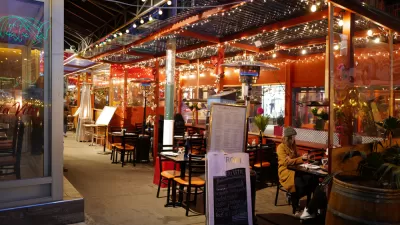Could New York City follow in the footsteps of...Vilnius?

After the Lithuanian capital city of Vilnius announced a plan to open 18 public open spaces in the historic core to al fresco dining and cafe uses, the idea has traction among prominent media outlets in New York City.
Tanay Warerkar writes for Eater New York to report that city officials are actually already pondering the idea, inspired not by Vilnius, but by the city's plan to open 100 miles of city streets to pedestrian and bike priority.
The possibility of moving restaurant seating to the streets was a question raised by a WNBC reporter at the Mayor’s press conference on Monday, an idea that de Blasio called “interesting.” The administration has “thought about it” and “begun discussions,” he said, though he added that it’s too early to unveil any plans. He went on to say that “there could be advantages to having more of it [restaurant seating] be outdoors.”
Writing for Slate, Henry Grabar expands the Vilnius model for consideration far beyond New York City, finding examples of cities already making new space for outdoor dining in space once reserved for cars. For instance:
In Brookhaven, a suburb of Atlanta, Mayor John Ernst has given restaurants permission to turn their parking into restaurant space. “For the next 90 days, Brookhaven will embrace alfresco dining,” he said.
Grabar's article concludes with the recommendation for choosing restaurants over cars in the wake of the pandemic—another version of the many choices facing U.S. communities as the the process of reopening the economy and daily lives threatens to significantly impact the patterns of daily life to the detriment of the environment and social and economic equity.
FULL STORY: NYC’s Restaurant Reopening Could Include Outdoor Seating On Closed Streets

Alabama: Trump Terminates Settlements for Black Communities Harmed By Raw Sewage
Trump deemed the landmark civil rights agreement “illegal DEI and environmental justice policy.”

Planetizen Federal Action Tracker
A weekly monitor of how Trump’s orders and actions are impacting planners and planning in America.

Why Should We Subsidize Public Transportation?
Many public transit agencies face financial stress due to rising costs, declining fare revenue, and declining subsidies. Transit advocates must provide a strong business case for increasing public transit funding.

Judge Orders Release of Frozen IRA, IIJA Funding
The decision is a victory for environmental groups who charged that freezing funds for critical infrastructure and disaster response programs caused “real and irreparable harm” to communities.

‘Clybourne Park’ Sets Stage for Housing Equity Discussions
Clybourne Park, a play exploring race, real estate, and community tensions, can set the stage for discussion on the lasting impacts of housing discrimination, gentrification, and the fight for affordability.

Understanding Road Diets
An explainer from Momentum highlights the advantages of reducing vehicle lanes in favor of more bike, transit, and pedestrian infrastructure.
Urban Design for Planners 1: Software Tools
This six-course series explores essential urban design concepts using open source software and equips planners with the tools they need to participate fully in the urban design process.
Planning for Universal Design
Learn the tools for implementing Universal Design in planning regulations.
Caltrans
Smith Gee Studio
Institute for Housing and Urban Development Studies (IHS)
City of Grandview
Harvard GSD Executive Education
Toledo-Lucas County Plan Commissions
Salt Lake City
NYU Wagner Graduate School of Public Service





























